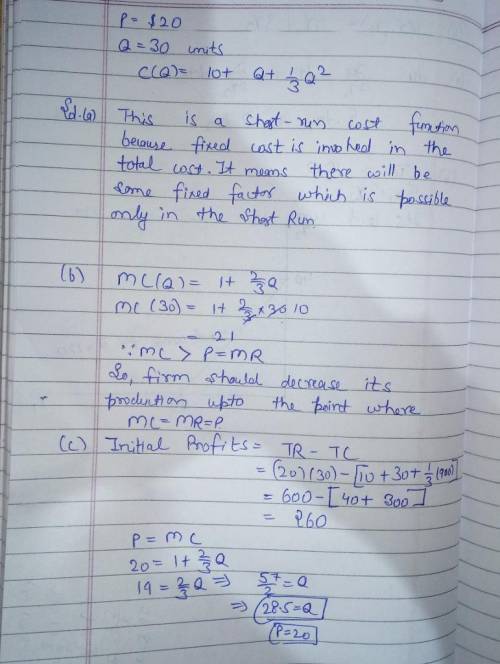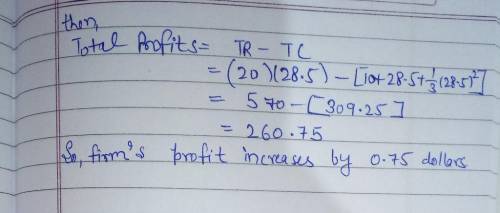
Suppose you are working for a firm producing cotton balls – an industry for which there are many different firms producing an identical product. the market price is $20 per case of cotton balls, and the firm is currently producing 30 cases. as the manager tasked with making production decisions for the firm, you begin by estimating the cost function, and find that the cost function is given by: = 10 + + 1/3 .
a. is this a short run or long run cost function?
b. what adjustments to the production decisions would you make to increase profits?
c. given your recommendation to (b) above, by how much would the firm’s profits increase?

Answers: 1


Other questions on the subject: Business

Business, 21.06.2019 17:00, giraffegurl
The risk-free rate is 7% and the expected rate of return on the market portfolio is 11%. a. calculate the required rate of return on a security with a beta of 1.92. (do not round intermediate calculations. enter your answer as a percent rounded to 2 decimal places.) b. if the security is expected to return 15%, is it overpriced or underpriced?
Answers: 2

Business, 21.06.2019 20:20, QUEEN2267
Atoy manufacturer makes its own wind-up motors, which are then put into its toys. while the toy manufacturing process is continuous, the motors are intermittent flow. data on the manufacture of the motors appears below. annual demand (d) = 50,000 units daily subassembly production rate = 1,000setup cost (s) = $85 per batch daily subassembly usage rate = 200carrying cost = $.20 per unit per year(a) to minimize cost, how large should each batch of subassemblies be? (b) approximately how many days are required to produce a batch? (c) how long is a complete cycle? (d) what is the average inventory for this problem? (e) what is the total annual inventory cost (holding plus setup) of the optimal behavior in this problem?
Answers: 2


Business, 22.06.2019 02:30, milkshakegrande101
The cost of capital: introduction the cost of capital: introduction companies issue bonds, preferred stock, and common equity to aise capital to invest in capital budgeting projects. capital is』necessary factor of production and like any other factor, it has a cost. this cost is equal to the select the applicable security. the rates of return that investors require on bonds, preferred stocks, and common equity represent the costs of those securities to the firm. companies estimate the required returns on their securities, calculate a weighted average of the costs of their different types of capital, and use this average cost for capital budgeting purposes. required return on rate: when calculating om operations when the firm's primary financial objective is to select shareholder value. to do this, companies invest in projects that earnselect their cost of capital. so, the cost of capital is often referred to as the -select -select and accruals, which a se spontaneously we hted average cost of capital wa c our concern is with capital that must be provided by select- 쑤 interest-bearing debt preferred stock and common equity. capital budgeting projects are undertaken, are not included as part of total invested capital because they do not come directly from investors. which of the following would be included in the caculation of total invested capital? choose the response that is most correct a. notes payable b. taxes payable c retained earnings d. responses a and c would be included in the calculation of total invested capital. e. none of the above would be included in the cakulation of total invested capital.
Answers: 2
You know the right answer?
Suppose you are working for a firm producing cotton balls – an industry for which there are many dif...
Questions in other subjects:






Mathematics, 16.04.2020 03:16

History, 16.04.2020 03:16








